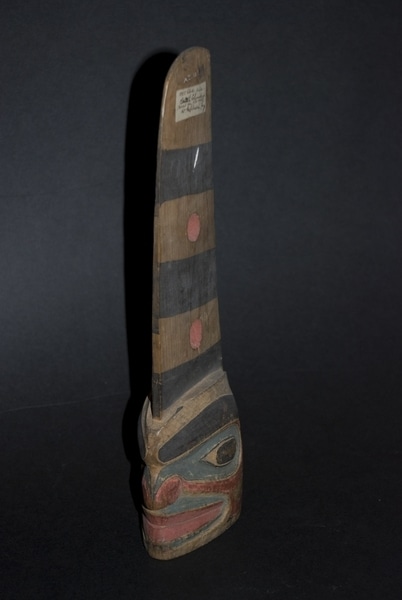Epaulette Item Number: 1885.66.6 from the MAA: University of Cambridge



Description
The catalogue card states this is a headdress, however it is more likely to be a epaulette which was worn on the shoulder (G.Crowther). The epaulette is carved in the form of a killerwhale fin, with a humanoid face at its base. The fin has two holes along its length and three painted bands of black. The face at the base is in profile, and has prominent black eyebrows, a greenish eye-socket, black eyes, and red paint accentuating the nostrils, cheeks and lips. the face is carved and painted. It is virtually identical to 1885.66.5, except the holes cut through the fin are painted red, and it is slightly smaller.; Good
Context
A provenance of Metlahkahtlah has been written in the hollow depression as the base of the fin. Metlahkatla was the model village founded by William Duncan, a lay preacher in 1862. At Metlahkatla Duncan encouraged the Tsimshian to give up their traditional lifestyle and convert to Christianity, he also encouraged several commercial enterprises, which included the manufacture of tourist art objects. However it is possible the fins were acquired at Metlahkatla by trade as many northern groups travelled to the Missionary town (G.Crowther). The information concerning the use of this object as an epaulette rather than a headdress comes from George Thornton Emmons The Tlingit Indians (University of Washington Press: Seattle 1991 Ed. Frederica de Laguna) page 366. It is noted that two very similar fins were worn on the shaman' s shoulders, on his dancing robe.; Exhibited: New Anthropological displays at CUMAA, wall case, 1990-.; Collected by: Hepburn.J.E
Item History
- Made in Alaska, USA and British Columbia, Canada ?
- Received from J.E. Hepburn during 1885
Who
- Culture
- Haida ? or Tlingit ?
- Received from
- J.E. Hepburn
Where
- Holding Institution
- MAA: University of Cambridge
- Made in
- Alaska, USA and British Columbia, Canada ?
When
- Acquisition Date
- during 1885
Other
- Keyword
- Masques and Drama; Magic and Religion; Medicine; Clothing; Ceremonial Objects